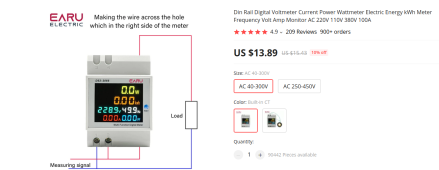I have assembled a small Victron off-grid setup with 2x100W of solar, a MPPT 100/20 and a Phoenix 12/500 inverter.
Purpose is to feed diverse low consumption home appliances like videogames console, fridge, computers,... but mostly experiment and learn.
I use for now some old 18650 battery pack to create a battery buffer that allows me to feed 100W stable to the inverter despite clouds temporarily shading the panels and most important, keep the MPPT always powered.
My final goals to complete the installation are two:
1) Add a big LiFePo4 battery (60-100Ah) to reach the 400W the inverter delivers.
2) Monitor the system accurately with special interest for the Victron VRM system using a Rasberry Pi as it seems dummy-doable.
Here is where my dilemma comes. Such desired would cost me a 12V 100Ah Victron battery a 1.000 eur approx. per piece while the same from another reputable brand (eg. Renogy) retails for the half or less.
A Victron battery can be integrated directly into the VRM environment. Another battery requires a Victron Smart battery monitor at a cost of 200 euros.
Victron battery specs while seem slightly better are fairly equal to the specs of other reputable brands like Renogy. The other brand's batteries can also be monitored with the supplier app, just not integrated in the Victron environment.
What would you do?
Would you spend all that money in the whim of monitoring? Or would you instead use the available data from the Victron Smart MPPT and the Battery software to have an approximate Excel sheet monitoring? Victron MPPT also provides trends for load and battery voltage, ampere,... so it should be enough, right? I also understand the basics so could understand with the trends what is going wrong or well.
Your comments are very appreciated. Including comments about the setup.
Purpose is to feed diverse low consumption home appliances like videogames console, fridge, computers,... but mostly experiment and learn.
I use for now some old 18650 battery pack to create a battery buffer that allows me to feed 100W stable to the inverter despite clouds temporarily shading the panels and most important, keep the MPPT always powered.
My final goals to complete the installation are two:
1) Add a big LiFePo4 battery (60-100Ah) to reach the 400W the inverter delivers.
2) Monitor the system accurately with special interest for the Victron VRM system using a Rasberry Pi as it seems dummy-doable.
Here is where my dilemma comes. Such desired would cost me a 12V 100Ah Victron battery a 1.000 eur approx. per piece while the same from another reputable brand (eg. Renogy) retails for the half or less.
A Victron battery can be integrated directly into the VRM environment. Another battery requires a Victron Smart battery monitor at a cost of 200 euros.
Victron battery specs while seem slightly better are fairly equal to the specs of other reputable brands like Renogy. The other brand's batteries can also be monitored with the supplier app, just not integrated in the Victron environment.
What would you do?
Would you spend all that money in the whim of monitoring? Or would you instead use the available data from the Victron Smart MPPT and the Battery software to have an approximate Excel sheet monitoring? Victron MPPT also provides trends for load and battery voltage, ampere,... so it should be enough, right? I also understand the basics so could understand with the trends what is going wrong or well.
Your comments are very appreciated. Including comments about the setup.



